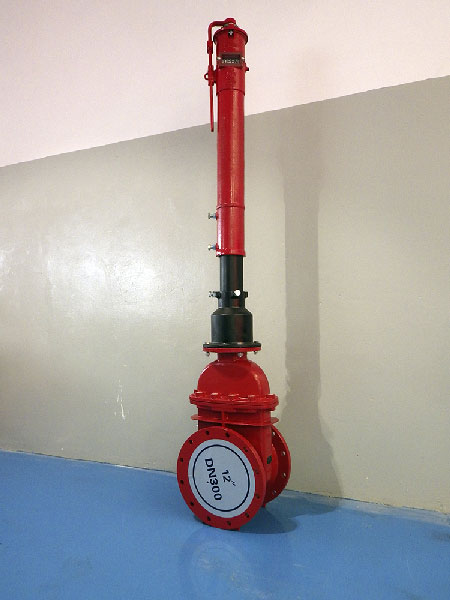A Post Indicator Valve (PIV) is a vital component in fire protection and water distribution systems, designed to clearly indicate whether an underground gate valve controlling water flow to a fire sprinkler or hydrant system is open or closed. The PIV not only provides easy visual monitoring but also allows firefighters and maintenance personnel to quickly control water supply in case of fire or maintenance operations.

Table of Contents
Toggle1. What Is a Post Indicator Valve?
A Post Indicator Valve is a specialized type of valve mounted on a post above ground, which operates an underground gate valve. The valve includes a visual window or indicator that displays either “OPEN” or “SHUT,” making it easy to determine the valve’s position from a distance.
This design is commonly used in fire sprinkler systems, fire mains, and industrial facilities where the main control valves are buried underground and need a simple and visible method for access and operation.
Main Components
A typical Post Indicator Valve includes:
Indicator Post: A vertical enclosure that extends above ground and provides access for valve operation.
Operating Wrench/Nut: Allows manual opening or closing of the valve stem.
Indicator Window: Displays the valve status (“OPEN” or “SHUT”).
Gate Valve: The buried valve that actually controls water flow in the pipeline.
2. How Does a Post Indicator Valve Work?
The Post Indicator Valve functions through a mechanical linkage between the above-ground post and the below-ground gate valve.
When the operating wrench is turned:
Rotating clockwise lowers the valve’s internal gate, shutting off water flow.
Rotating counterclockwise raises the gate, allowing water to flow.
As the valve stem moves, the indicator mechanism inside the post simultaneously rotates, showing either “OPEN” or “SHUT” through a small glass window — giving operators a clear, unambiguous visual indication of the valve’s position.
3. Applications of Post Indicator Valves
Post Indicator Valves are most commonly used in:
Fire protection systems (sprinkler mains, hydrants, and fire pumps)
Industrial plants where underground piping requires easy visual monitoring
Commercial buildings and warehouses with large fire suppression networks
Municipal water distribution systems for sectional control and safety
Their primary function is to ensure that the main control valves of fire sprinkler systems are easily accessible, identifiable, and tamper-resistant.
4. Types of Post Indicator Valves
Depending on design and application, PIVs are available in several configurations:
Freestanding Post Indicator Valves: Installed directly above the buried valve; ideal for open spaces or outdoor fire mains.
Wall Post Indicator Valves: Mounted on building exteriors when the valve is located close to a wall or structure.
Underground (Non-Rising) Post Indicator Valves: Designed for use in limited-space or frost-prone areas where standard posts cannot be installed.
5. Advantages of Using Post Indicator Valves
Post Indicator Valves offer multiple operational and safety benefits:
✅ Clear Position Indication: Easily shows whether the valve is “OPEN” or “SHUT.”
✅ Firefighter Friendly: Enables rapid water control during fire emergencies.
✅ Tamper Resistance: The valve can be locked in either position to prevent unauthorized operation.
✅ Corrosion Protection: Protects the operating components of underground valves from soil and water damage.
✅ Durability: Made from robust materials such as cast iron or ductile iron, suitable for outdoor environments.
6. Installation and Maintenance Considerations
Installation Tips
The PIV should be located between 1.5 and 3 meters (5–10 ft) from the protected building, as per NFPA (National Fire Protection Association) standards.
It must be readily accessible to fire department personnel.
The arrow on the post should align with the direction of water flow.
Maintenance Practices
Regularly operate the valve (at least twice a year) to prevent seizing.
Inspect the indicator window for visibility and cleanliness.
Lubricate the operating nut and inspect for corrosion.
Verify the “OPEN” and “SHUT” indications correspond with actual valve position.
7. Standards and Compliance
Post Indicator Valves are designed and installed according to standards such as:
NFPA 24 – Installation of Private Fire Service Mains and Their Appurtenances
UL/FM Approved Valves – Certified for reliability in fire protection systems
AWWA Standards – For use in municipal water supply systems
These standards ensure that PIVs provide dependable performance in critical fire protection and water control applications.
8. Conclusion
A Post Indicator Valve serves as the guardian of water flow control in fire protection systems. By providing a clear visual indication of valve status and allowing quick manual operation, PIVs enhance both safety and system reliability.
Whether installed in commercial facilities, industrial plants, or municipal networks, the Post Indicator Valve remains an essential part of modern fire protection infrastructure — ensuring that when an emergency occurs, water is always available when and where it’s needed most.
